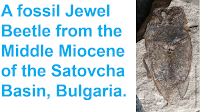Unusually rich fossil deposits, known as Lagerstätte, provide much of our knowledge about the ecology of the prehistoric world. These sites tend to preserve a wider range of fossils than other locations, and often preserve fossils in exceptional detail, allowing palaeontologists to reconstruct ancient ecosystems. Our knowledge of the Eocene Epoch is largely dependent on a series of exceptional Lagerstätte, from the Northern Hemisphere, particularly Germany, with relatively few such deposits from the Southern Hemisphere. Notable exceptions to this are the Orapa Kimberlite Pipe of north-central Botswana, where numerous well-preserved Insects and other organisms are found in a fine-grained mudstone, and the maar deposits of north-central Tanzania, which have produced a variety of fossils.
Beetles tend to yield few details when fossilised, and this is particularly true of Scarabs. The compact, strongly sclerotised exoskeletons of Scarabs gives them good preservational potential, but also means that where they are found as fossils, usually only the body outline can bee seen, possibly with some legs. In other Beetles quite often only the elytra (wing cases) are preserved, which means that well preserved Beetles from sediment deposits are rare.
When fossil Beetles can be identified as Scarabs, this is usually upon the basis of one of four features; a lamellate club on the antennae, pronotum and fore legs adapted for burrowing, reduced wing venation and an intrinsic spring mechanism for folding the wings.
Molecular studies of the Coleoptera have suggested that the Scarabaeoidea are likely to have originated in the Triassic, with the major Scarab groups appearing in the Jurassic and radiating in the Cretaceous, alongside the radiation of the Flowering Plants. Fossil Scarabs are known from the Middle Jurassic onwards, but only about 230 fossil species have been described to date, compared to about 30 000 extant species. A number of Late Cretaceous species are known, along with a few Palaeocene specimens seven from the Eocene, a few Oligocene species, and two Pliocene ones. The majority of known Scarab fossils date from the Miocene and later, at the time when grasslands were spreading, and various Mammal groups radiating with them. Only six fossil Scarabs are known from the Eocene, one from Baltic Amber, one from Menat in France, one from Bognor Regis in England, two from Geiseltal in Germany, and one from the Green River formation of North America. African fossil Scarabs have previously been described from the Cretaceous of Botswana, the Miocene of Kenya, and the Pliocene of Tanzania.
In a paper published in the South African Journal of Science on 29 March 2023, Werner Strümpher of the Ditsong National Museum of Natural History, Clarke Scholtz of the Department of Zoology and Entomology at the University of Pretoria, and Thomas Schlüter of the Department of Geography, Environmental Science and Planning at the University of Eswatini, describe a new species of Scarab Beetle from the Eocene Mahenge Maar Lagerstätte of north-central Tanzania.
The Mahenge Maar deposits were discovered by diamond prospectors in the 1930s, and produce a variety of finely preserved fossils in shales and mudstones laid down in a former crater lake overlying a kimberlite deposit. The lake was about 400 m in diameter, and surrounded by a steep-sided tuffaceous cone of largely fine-grained ashes, which provided sediments deposited into the lake, creating well-stratified, microlaminated shale and mudstone deposits in the lake centre.
The Mahenge deposits were originally determined to be Miocene based upon the fossil Fish assemblage, which was later revised to Oligocene. However, uranium-lead dating of other kimberlite deposits in the area suggested that these deposits were of Palaeocene or Early Eocene age. A zircon collected from the Mahenge Lake deposits in 1968, and believed likely to have been incorporated into those deposits shortly after being erupted, gave a uranium-lead age of 45.83±0.17 million years, which would make the lake deposits Middle Eocene in origin.
Palaeobotanical evidence from the Mahenge deposits suggests that the lake was surrounded by a savanna-woodland similar to the Miombo Woodland found across much of Southern and East Africa today, with a dry but strongly seasonal climate.
The Mahenge Lagerstätte yields compression fossils in a fine-laminated, pale beige, clayey-calcareous lake sediment. The fossils are preserved as a film of organic or iron-containing material, with reddish brown, brown, or black colouration. Fine details are preserved, but are often lost to weathering, or the formation of small iron or manganese bubbles on the fossil surface. Fish are the most common fossils in the assemblage, making up about 51% of the total, followed by Plant fossils, making up 36%. To date, only nine Insect fossils have been identified from the Mahenge deposits, most of which are poorly preserved.
The new species is described from a single specimen, preserved as part and counterpart on a split piece of Mahenge shale. It is given the name Mahengea mckayi, where 'Mahengea' is derived directly from Mahenge and 'mckayi' honours the late Ian Mckay (1963–2022), an insect fossil curator, palaeoentomologist and geoscience outreach educationist extraordinaire at the University of the Witwatersrand.
The specimen is an adult Beetle, almost complete, although parts of the head and legs are poorly preserved. The body is about 18 mm long, robust, and roughly cylindrical, and the forelimbs appear to be adapted for digging. One wing is clearly visible in an outstretched position.
See also...
Online courses in Palaeontology.
Follow Sciency Thoughts on Facebook.
Follow Sciency Thoughts on Twitter.








